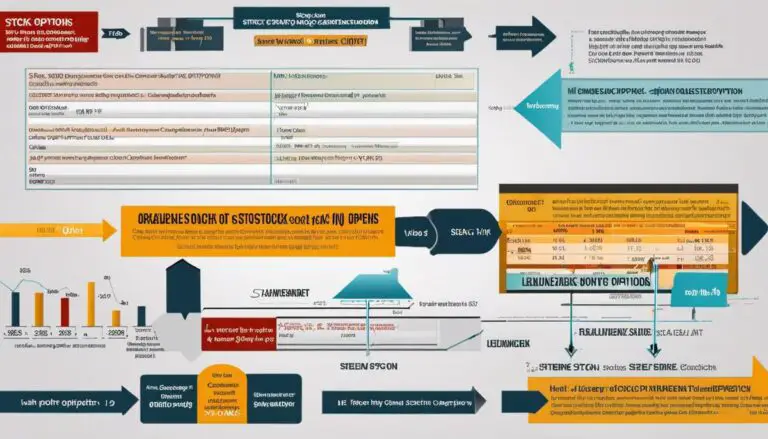Interest rates sit at the heart of the global economic narrative, quietly but decisively orchestrating the rhythms of market activities and investor behaviors. As we embark on a journey through the intricate world of interest rates, their pervasive influence will be revealed, shedding light on the fundamental ways these figures shape financial destinies. Discover the pivotal role of central banks and the ripple effects of their monetary policy decisions, which echo through the corridors of corporate profitability to the broader stock market landscape. Through this exploration, we provide a map for navigating the oft-murky waters of the stock market’s reaction to interest rate adjustments, preparing you to make informed decisions in anticipation of these economic tides.
Interest Rates 101: The Basics and Mechanisms
The Intricate Dance of Interest Rates and The Stock Market
In the dynamic interplay of economic elements, interest rates stand as decisive conductors orchestrating the ebb and flow of stock markets. The relationship is not merely causal; it’s fundamentally intertwined. Interest rates, determined by the Federal Reserve in the United States, are the cost of borrowing money. When they’re low, capital is cheaper, encouraging businesses and individuals to borrow and spend. This infusion of borrowed funds translates into higher corporate earnings and consumer spending, bolstering investor confidence, and, by extension, elevating stock market valuations.
Conversely, when interest rates climb, the cost of borrowing escalates, prompting a tightening of the financial purse strings. Businesses rethink expansion plans, while consumers scale back on credit-fueled expenditures. As the flow of money constricts, corporate profits may wane, investor sentiment often sours, and stock market indices may retract as a reflection of this anticipated decline in economic activity.
Moreover, one must appreciate that the stock market is forward-looking. Astute investors scrutinize interest rate trends, anticipating shifts even before they occur. A mere hint of interest rate adjustment by the Federal Reserve can send stock prices in a tizzy, as portfolios are rebalanced in expectation of the change.
In the world of investments, fixed-income assets also play a critical role. Interest rate hikes typically bolster the allure of bonds, offering steady returns with less risk. This heightened appeal can lead to a migration of capital away from equities, putting downward pressure on stock prices.
However, context is king. Not all sectors are equally affected by changing interest rates. Financial institutions, for instance, may actually profit from a rising rate environment, as the margin between their borrowing costs and lending rates can widen. On the other hand, industries heavily reliant on borrowing, such as real estate and utilities, might find themselves on the less favorable end of the spectrum.
Furthermore, one cannot overlook the implications of international investments. Global traders play a game of relative advantage. As U.S. interest rates ascend, international investors are often drawn to American shores, eager for a piece of the higher yield pie, and this influx of foreign capital can buoy domestic markets.
The mastery of navigating the stock market necessitates a keen understanding of the nuanced way interest rates influence these financial waters. Whether one is a burgeoning entrepreneur or a seasoned investor, the capacity to anticipate and react to the central bank’s interest rate strategies proves indispensable. It’s a high stakes game, where the vigilant and the well-informed thrive. Stay connected, stay informed, and stay ahead of the curve – when interest rates move, ensure that your strategy is already in play.

Analyzing the Interest Rate-Stock Relationship
Harnessing Historical Clues: Aligning Investment Strategies With Interest Rate Swings
Decoding the intricacies of historical trends shines a beacon on the symbiotic dance between interest rates and stock performances, offering investors a roadmap to potentially fortify their portfolios against future economic swirls. A deep dive into economic history reveals a patterned interplay where smart investors have long parsed through central bank tea leaves to align their strategies for capitalizing on interest rate-induced stock market shifts.
Consider the bullish persuasion embraced during periods of dipping interest rates. History illuminates that such an environment typically spurred a zest for equities, as lower borrowing costs fed corporate expansions and consumer spending, driving earnings and stock prices northward. On the flip side, a hawkish response gripped investors as rates ascended, with the associated cost pressures and borrowing constraints often ushering in a cooling effect on both corporate growth and, sequentially, equity enthusiasm.
However, the learning does not end at the causal relationship between interest rates and market sentiment. A granular analysis into sector-specific performances opens an investment playbook ripe with strategic maneuvers. Historically, financial sectors often reveled in the upsurge of interest margins brought forth by rate hikes, while capitalized, asset-light tech industries deftly navigated the rough seas of rate elevations, frequently maintaining their growth trajectories despite macroeconomic pressures.
But the narrative does not merely orbit domestic policy. Interest rates, in their global gait, have historically attracted international capital flows, chasing the yields offered by countries’ financial instruments—a reality not lost on multinational corporations and astute investors alike.
Central to leveraging these historical lessons is recognizing the central bank’s dual message: present-day action and future intentions. Herein lies the foresight to decipher the swirling economic winds, propelling the informed investor to navigate their ship with prescience, tapping into sectors historically buoyant amidst the fluctuating tides of interest rates.
Historical trends, in their majesty and complexity, instruct the observant. They caution against a one-size-fits-all approach, advocating for a keen understanding of sectoral dynamics, a nimble adaptation to international flows, and an eternal vigilance towards central bank strategy. To stand on the shoulders of history is to peer further into the horizon of investment opportunities—and in the nuanced realm of interest rates and stocks, this vantage point is nothing short of essential.

Sector-Specific Impacts and Strategies
Shifting interest rates create waves across various sectors – some surf the tide, others flounder beneath the chop.
Let’s pivot and identify the sectors positioned to capitalize when interest rates gyrate, as well as those bracing for impact.
Technology and Innovation sectors, often the darlings of growth and expansion, react differently to interest adjustments. Typically financed through extensive borrowing, they can stagnate as capital costs climb. Yet, this same environment encourages ingenuity. Efficient capital deployment becomes paramount; productiveness and creative financing structures like convertible debt become trendy.
Consumer Discretionary is another domain to watch. Higher rates can squeeze disposable income, tampering with retail extravagance. Nonessential purchases might take a backseat. This trickles down, impacting manufacturing and service behavior. Adaptability is crucial – the strongest players pivot towards value offerings and targeted marketing to entice frugal buyers.
Healthcare, often considered a defensive sector, exhibits resilience amidst rate variations. People don’t compromise on health – so demand stays consistent. Moreover, the sector’s long-term horizon for ROI withstands short-term shifts. What’s more, demographic trends like aging populations ensure a steady, inelastic demand curve.
Commodities exhibit a noteworthy response. Precious metals like gold typically falter as yield-bearing investments become more alluring. Conversely, commodities tied to economic activity, like oil or copper, may benefit indirectly from heightened rates curbing excessive growth, thus mitigating the risk of inflation.
On the other side, Utilities emerge subdued but stable. They usually carry high debt loads for infrastructure projects, making them sensitive to interest rate spikes. Yet, routine consumption and regulatory frameworks provide a buffer, promising consistent revenue streams even in tight monetary periods.
Contrastingly, cyclicals like Automotive and Housing are prone to strain. As borrowing costs rise, the financing of homes and vehicles become pricier, dampening demand. Yet industrial wisdom innovates: offering smart financing solutions, diversifying product ranges, and optimizing supply chains can help circumvent the tidal pull of increasing rates.
Amidst this landscape, the savvy entrepreneur doesn’t just observe – they strategize. Rate shifts aren’t just a hurdle, they’re an invitation to the astute innovator. The key lies in product and service evolution to exploit new spending behaviors, and the implementation of financial acumen to derive robust models resilient against the ebb and flow of fiscal tides.
In summation, when interest rates shift, sectors that lean heavily on innovation, agile business models, and inherent demand stay buoyant. Others, tethered to consumer spending and significant debt, tend to stagger. For those in the entrepreneurial and investment realms, this isn’t a mere economic observation – it’s essential intel for steering the helm of business and investment strategies in tumultuous monetary conditions. Keep a keen eye, think critically, and move boldly. The dance of interest rates is not a step backward but a strategic pivot.

Interest Rates and the Global Stock Influence
Global Interest Rate Trends: Decoding the Ripple Effect on Domestic Stock Markets
In navigating the vast ocean of domestic stock markets, understanding the undercurrents created by global interest rate trends is crucial. These ripples traverse boundaries, reflecting in the performance of indices and individual stocks alike. When the global tide of interest rates rises or falls, savvy entrepreneurs and investors alike keep their fingers on the pulse to harness the wave’s potential or brace for impact.
Capital Allocation Shifts and Stock Valuations:
In an environment of fluctuating global rates, the allocation of capital undergoes a transformation, influencing allocations domestically. Funds often seek the best returns adjusted for risk. A rise in global interest rates may siphon off capital from domestic stocks to more attractive, higher-yielding foreign assets. Conversely, when international rates drop, capital may flood back, buoying domestic equities.
Leveraging Currency Fluctuations:
Interest rate divergence can lead to significant currency fluctuations, with direct consequences for multinational companies. An appreciation in the local currency, tied to rising rates, could make exports less competitive, impacting the bottom line of industries reliant on global markets. Import-heavy sectors, however, could benefit from a stronger currency making foreign goods less expensive, thus affecting stock valuations.
Derivative Markets and Hedging Strategies:
As interest rates fluctuate, derivative markets gain prominence. Savvy investors use these instruments to hedge against potential losses or speculate on future interest movements. Options, futures, and swaps become increasingly integral, influencing stock market liquidity and volatility.
Emerging Markets and the Spillover Effect:
It’s essential to consider the vulnerability of emerging markets to global interest rate swings. A spike in rates often translates into capital outflows from these markets as risk aversion rises, affecting domestic companies with significant exposure to these regions. Risk management and diversification become essential tactics for business leaders and investors with stakes in emerging market assets.
Central Banks’ Communication and Market Sentiment:
The narrative from central banks can be as influential as the interest rates themselves. Forward guidance and policy projections can trigger market reactions before any actual rate change. Markets hang on every word, with analysts deciphering the subtext for indications of future trends, underscoring the importance of interpreting central bank communications astutely.
Synthesizing Global and Domestic Signals:
Many corporations and entrepreneurs have learned to synthesize global and domestic signals to achieve strategic positioning. They calculate the cross-border impact on supply chains, cost of capital, and consumer demand, reorienting their business models to mitigate risks and capitalize on opportunities.
Influence on Margin Debts and Leverage:
Interest rate variations also weigh on the level of margin debt and leverage within the stock market. When rates are low, margin debts tend to increase as investors borrow cheaply to fuel stock purchases, potentially inflating market valuations. As rates ascend, servicing this debt becomes costlier, sometimes leading to deleveraging and increased selling pressure on stocks.
In conclusion, global interest rate trends send shockwaves that are felt within domestic stock markets. Whether it’s shifting capital flows, currency impacts on multinational businesses, the use of derivatives for hedging and speculation, the heightened sensitivity of emerging markets, or the subtle communication of central banks, the interconnection is undeniable. Navigating these global-financial dynamics demands a vigilant, informed, and adaptable approach, ensuring decisions are not merely reactive but strategically proactive, positioning for growth or battening down the hatches in anticipation of rougher seas ahead.

Forecasting and Adaptation to Interest Rate Changes
Navigating the Impacts of Interest Rate Adjustments on Business and Investment
In the dynamic world of finance, understanding the ramifications of interest rate changes is paramount. Businesses and investors, now more than ever, must remain agile, diversifying their strategies to stay afloat and prosper. With central banks playing a game of economic chess, deploying precise tactics can be the lifeline in weathering financial turbulence.
Capital Dynamics in a Fluctuating Interest Rate Environment
As rates pivot, so should the approach to capital allocation. Valuations are intimately tied to the cost of capital, prompting a reassessment of investment portfolios. In higher rate climates, value stocks often emerge as havens, given their less reliance on future growth promises. On the flip side, growth-oriented investments might take a backseat, as the present value of their long-term cash flows diminishes.
The Currency Conundrum
Interest rate adjustments inevitably stir currency markets. A stronger currency can suppress export competitiveness but benefit importers. Conversely, a weaker currency might boost export sectors but could raise the cost of imported goods and services. Strategic currency management, including natural hedges through geographic revenue distribution, is essential in protecting and enhancing cross-border trade and investments.
Harnessing Derivatives to Shield Portfolios
The derivatives market burgeons as a playground for risk mitigation. Interest rate futures, options, and swaps become critical instruments in insulating portfolios from adverse rate movements. Investors can lock in borrowing costs or secure a favorable interest income stream, providing a safeguard against volatility.
Emerging Markets: The Domino Effect
Interest rate hikes in major economies often lead to capital outflows from emerging markets as investors chase higher yields elsewhere. However, this exodus creates opportunities for those with a risk appetite to scoop up undervalued assets. Conversely, rate cuts can attract capital to these regions, prompting a vigilance for inherent political, currency, and liquidity risks.
Deciphering Central Banks’ Signals
Central banks’ rhetoric and policy guidance carry substantial weight. Timely interpretation of their communication helps in predicting policy direction and can offer a competitive edge. Market participants should not only listen but read between the lines of central bank discourse to gauge future economic and financial market trends.
Synchronizing Global and Domestic Indicators
In an interconnected world, international economic indicators can serve as a harbinger for domestic rate decisions. For instance, a robust employment report in a leading economy might suggest imminent rate rises, prompting preemptive portfolio adjustments.
Margin Debt: A Double-Edged Sword
Investment leverage swells in low-rate environments as borrowing to invest becomes enticing. However, this margin debt can backfire when rates ascend, escalating the cost of servicing this debt and potentially triggering a sell-off as investors scramble to cover margin calls. Prudent leverage management becomes a cornerstone of robust investment planning.
To conclude, fluctuating interest rates set off a complex domino effect across industries and geographies, demanding a multifaceted approach to business and investment strategy. Clarity, agility, and strategic hedging are the order of the day, ensuring businesses and investors not only protect their interests but capitalize on the opportunities that interest rate shifts bring.

The landscape of interest rates offers a dynamic theatre where economic indicators, strategic foresight, and the tenacity of investors play out momentous scenes influencing the stock market. Equipped now with the knowledge of how these rates interact with market mechanisms, sector susceptibilities, and global economic shifts, you stand at the helm, ready to steer through upcoming fiscal fluctuations. Let this comprehensive voyage of discovery serve as a beacon, empowering you to adapt with agility to the ebb and flow of interest rates and seize the investment opportunities that lie within tomorrow’s financial horizons.



